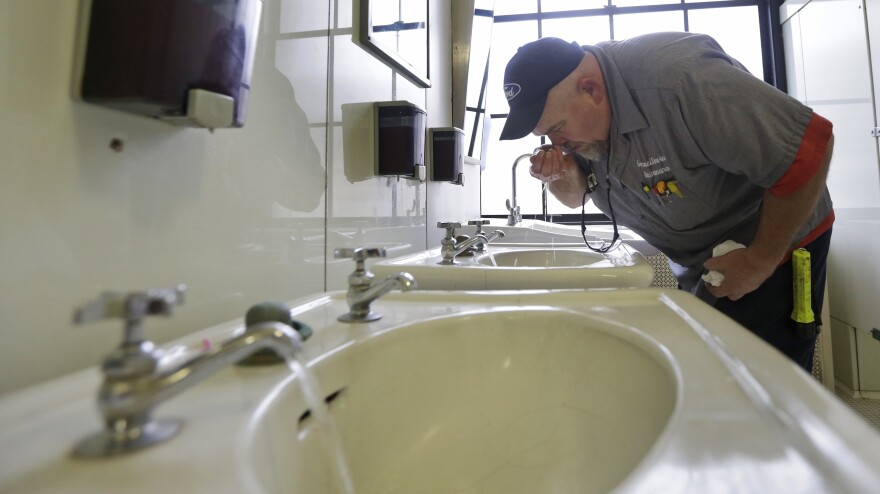The fact that a second contaminant in West Virginia's drinking water eluded detection for nearly two weeks — despite intense testing of the water — reveals an important truth about how companies test drinking water: In most cases, they only find the contaminants they're looking for.
Freedom Industries earlier this week revealed it had spilled two chemicals, not just one. The second chemical is PPH, a mixture of polygycol ethers. It was combined with first contaminant — 4-methylcyclohexanemethanol, or MCHM — a chemical that washes coal.
PPH made up about 7 percent of the contents of the tank that spilled into the Elk River, about 1.5 miles upstream from the treatment plant's intake.
Experts say it's not surprising that the drinking water company did not detect a second contaminant during its search for MCHM. Laboratories can hunt for unexpected chemicals, but generally they don't.
"When water companies do specific tests on contaminants like this they look for a fingerprint, if you will," says Brent Fewell, senior vice president of environment, health and safety of a different water company, United Waters. "Every chemical has a chemical fingerprint. And so when you focus on that fingerprint and you're not focusing on other fingerprints, you very well could miss a contaminant like this."
There are tens of thousands of chemicals in use.
"To expect a water company to monitor for thousands of chemicals, it just is not practical and it would be cost-prohibitive," added Fewell, whose company works with more than 100 drinking water systems.
The federal Environmental Protection Agency does require public water systems to test for about 80 contaminants, but not the ones that spilled from Freedom Industries' tank.
"The substance involved here, PPH, is not a substance for which West Virginia American Water Company is required to test for under the Safe Drinking Water Act," says Jon Capacasa, who directs EPA's water protection division for the region that includes West Virginia.
How frequently water companies have to test varies on the kind of health risk the contaminant presents. Viruses and bacteria that can present acute health risks may be monitored every few hours. Heavy metals, radiation and chemicals that may increase cancer risks over a long period of exposure are tested much less frequently — every few months, or even years.
Water companies don't regularly test for tens of thousands of other chemicals.
This limitation of testing makes it essential that companies that spill chemicals tell utilities about all the chemicals that might have spilled, regulatory agencies and water companies say.
Labs Can Hunt Unknown Chemicals
There are some analytical technologies laboratories can use to cast a wider net for unknown chemicals.
Labs hired by American Water were using one of those technologies, called gas chromatography mass spectrometry, to test for the primary contaminant, MCHM.
One of those laboratories, MATRIC, told NPR in an email that before it learned PPH was also spilled, it did not "pursue the concentration of other constituents" in the water.
Andy Eaton, the technical director of a water testing laboratory in California, Eurofins Eaton Analytical, says these broader searches can find unexpected contaminants.
Twenty years ago, chemists from his company were using one of these broader searches to analyze a routine water sample. They found something that surprised them, MTBE, a gasoline additive.
"And everybody sort of said what? What's MTBE? What's it doing there?" Eaton recalls.
Eaton says it would be too expensive to use this technology to hunt for contaminants on a daily basis.
But, he says there's an important takeaway here for water companies that face chemical spills in the future: "Learn to not take the information that you're given at face value."
Results from initial tests ordered since American Water West Virginia learned about the PPH did not detect the second contaminant in 30 samples drawn from the intake and outflow of the treatment plant since Jan 10. The threshold used was 2 parts per million. More rigorous tests now will be used to determine if the chemical was present at lower concentrations.
American Water lifted the last "do not use order" last week for West Virginia residents in areas affected by the spill. But following guidance from the Centers for Disease Control and Prevention, pregnant women were still urged to consider an alternative source of drinking water.
In testimony Friday, the federal Chemical Safety Board told a West Virginia Senate committee that no amount of PPH or MCHM in drinking water is acceptable.
Copyright 2021 NPR. To see more, visit https://www.npr.org. 9(MDAxNzg0MDExMDEyMTYyMjc1MDE3NGVmMw004))




